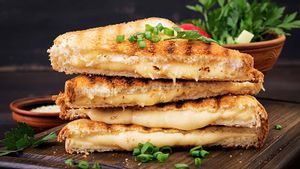I don’t know anybody who doesn’t love cheese, barring the few people who are intolerant to dairy products. By and large, I think, cheese goes down well with the Indian palate.
Cheesy childhood memories
As a child, I used to be fascinated with the mixed cheese packets that my uncle, who lived abroad would get for us. The Edam and Gouda used to be my favourite along with another Dutch cheese, which I learnt later was called Delfts Blauw (also called Bleu de Graven), the bluish bacteria infused smelly cheese that disgusted most Indians, but delighted me, of course.
In those days, India did not have much variety of cheese, other than the ubiquitous Amul cheese, and of course, the cottage cheese or the humble paneer that is not really cheese.
But when you talk about cheese in its true avatar, as the West knows it, the mind-boggling variety and range never cease to surprise. Though there are exclusive cheese-producing regions in the world, most cities and small towns produce their local version of cheese, which is just pressed curd or coagulated milk protein, even in India. In Punjab, where paneer originated, it is made by splitting hot milk with yoghurt or buttermilk.
Homegrown cheese in India

As a former physicist and now cheese maker Aditya Raghavan tells us, “India is home to some really interesting indigenous cheeses.”
The tribal communities in the Himalayas churn butter out of yoghurt and convert buttermilk into chhurpi cheese. Fresh chhurpi is soft and creamy with a tangy flavour. In Sikkim, it is used to finish stir-fry vegetables or in chutneys. Ema Datshi—the national dish of Bhutan—employs a cheese similar to chhurpi. It is sometimes smoked and dried to give it a really hard texture. Moo Chura in Arunachal Pradesh is again similarly made.
Fermentation of milk is key to all these cheeses. Fermentation allows dairy herders and pastoralists to extend the life of fresh milk. The fermented milk is then separated into butter—the high fat, high-value food in these parts—and buttermilk, from which these cheeses come.
Kalari cheese is another traditional cheese made by the nomadic Gujjars and Bakkarwals in Kashmir. It is a stretchy cheese like mozzarella that has a dry and rubbery texture at room temperature. It is often consumed by heating on a pan and mixed with chopped onions and tomatoes. When warmed, the rubbery texture changes to gooey and melty, making it quite an enjoyable bite.
This treatment in making Kalari gives this cheese a slightly longer life and is another example of fermented and preserved milk. Rushan cheese in the Yunnan province of China is of a similar category to Kalari. Rushan is traditionally stretched and rolled into cones, using chopsticks.
Cheese techniques from Central Asia in India
Topli nu Paneer is a classic Indian cheese made by the Parsis and bears similarities to fresh cheeses from Central Asia and Europe. It is an enzyme-coagulated, jelly-like, soft cheese made in baskets and is closest in texture, taste and technique to Queijo Fresco from Portugal.
Sometimes used in wedding feasts and other special feasts such as Navroz, there are only a handful of producers of this cheese in Mumbai. Texts from the late 19th century and early 20th century suggest that this traditional cheese was made by adding enzymes extracted from chicken gizzards to milk.
Cheese in Kolkata
Another desi variety of cheese is the Bandel cheese that comes from the town of Bandel near Kolkata. The Portuguese introduced West Bengal to the idea of splitting hot milk with acid like vinegar. This led to the development of chenna and chenna-based foods like rasgulla.
Bandel production starts in a similar fashion. The chenna is heavily salted and smoked, making it firm, yet creamy cheese with a salty taste and strong smoky flavour.
Indie brands of packaged cheese
Other than the processed cheese that you get in supermarkets all over the country, from brands such as Britannia and Amul, there are some small dairies like Dairy Craft which are doing a variety of processed gourmet cheeses.
Among the artisan cheesemakers, there are about 20 creameries that are making cheese in the traditional handmade ways with only natural preservatives. However, this number is gradually increasing. According to Dhvani Desai, a former business journalist and now cheesemaker and owner of Casa Del Cheese in Mumbai that produces premium quality artisanal cheese, among the imported varieties, “You can find slightly better quality cheeses that come from good dairies. And some which are cheap imports which can contain as high as 50 per cent vegetable or palm oil in the cheeses.”
Cheese and Food Pairing Tips
- Avoid any fruit, wine or condiment that is very citrusy or overly acidic. If using orange and pineapples they should be extremely ripe and sweet.
- Indians love spicy condiments but spicy pestos, condiments, spicy crackers go well only with very few kinds of cheeses. The spice quotient may kill the taste and subtle flavours of some cheeses.
- Avoid very highly aged red wines such as the ones with high tannin levels. They have bitter notes and make the cheese really bitter as well.
- Avoid using other bitter condiments like strong tea or coffee with brie-style cheese. Tea and coffee go well with fresh and mild cheese.




